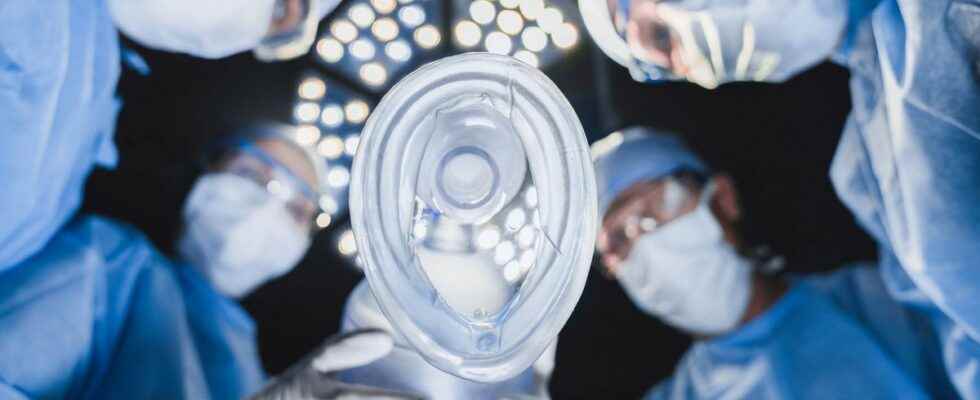Published on
Updated
Reading 4 mins.
in collaboration with
Dr Laure Martinat (Anesthetist-resuscitator, Naturopath, graduate in Phytotherapy and Aromatherapy)
During surgery performed under general anesthesia, some patients sometimes wake up. Although the origin of this phenomenon is still debated, a researcher is trying to develop a more efficient tool to detect intraoperative awakenings. The point with Dr Laure Martinat, resuscitator anesthesiologist and member of the Doctissimo expert committee.
Intraoperative awakening: a traumatic experience
Waking up in the middle of an operation? Yes, that is indeed possible. It’s not an experience you only see in the movies. Between 1 and 2%: this is the incidence rate of intraoperative awakening (i.e. the patient wakes up suddenly during a surgical operation under general anesthesia) according to a study. A percentage that may seem low. However, it must be taken into account that some people do not testify to this traumatic experience or others were not even aware of their awakening during the surgical intervention. A patient had declared in 2015 “I couldn’t breathe, I couldn’t move or open my eyes, or even tell the doctors that I wasn’t asleep…”.
“Awakenings during an operation under general anesthesia are fortunately extremely rare thanks to the progress made over more than 20 years – in particular in terms of monitoring the patient during general anesthesia”, testifies Dr. Laure Martinat. She also adds that “this can occur when the anesthesia is insufficient in terms of the dose of drugs used, for example during a code red for an emergency caesarean section. It can also occur through failure of monitoring systems.
“The boundary between correctly dosed or too light anesthesia is often very thin in the end… Mainly because of the heterogeneity of the patients (age, weight, gender) and their physiological reaction to the products used”says Sébastien Rimbert, post-doctoral researcher at Inria Bordeaux Sud-Ouest who brought together researchers during an interdisciplinary consortium to talk about a new means capable of accurately detecting intraoperative awakenings.
Still according to Dr. Laure Martinat, there are many ways to avoid awakenings during general anesthesia, especially when it is insufficient. “First of all, the patient is constantly monitored throughout the perioperative period with different measuring devices: heart rate and blood pressure can indicate insufficient anesthesia when they rise”.
The expert also adds that other signs can be revealing: “We also observe the patient. Movements and sweating are evocative signs. In addition, we continuously record the anesthesia drugs that are delivered to the patient, whether intravenously or by respiratory route (anaesthetic gases) in particular their concentration, which also allows us to better control the depth of anesthesia”.
According to Sébastien Rimbert, relying solely on clinical signs to know sufficient detection of the patient’s awakening is not enough. In short, this does not prevent these intraoperative awakenings either.
A future brain-computer interface for better detection accuracy?
“We also have at our disposal specific tools dedicated to monitoring the depth of anesthesia such as the Bispectral or BIS index which records the patient’s cerebral activity (encephalographic tracing). These tools and these different parameters therefore allow us to optimize our anesthesia and above all to personalize it”says Dr. Laure Martinat.
But in addition to having this tool available, Sébastien Rimbert hopes to develop a more precise means of detecting preoperative awakenings. It would be a brain-computer interface. Its name: the BCI4IA project (Brain-Computer Interface for Intraoperative Awareness). Three major objectives have been defined in this project:
- Investigate the effect of anesthetics on the electroencephalogram (EEG) signal of the motor cortex using new signal tracking techniques;
- Succeed in detecting a patient’s neural signature in the EEG signal, without knowing precisely when he will wake up;
- Develop a brain-computer interface that can operate in a clinical setting without a calibration phase. Current interfaces require prior calibration for each patient. The reason: the characteristics of EEG activity are very variable from one patient to another.
“I have already demonstrated that stimulation of the median nerve (for the anterior aspect of the forearm and hand) is a very promising approach : indeed, it also induces changes in the cortical activity visible in the signal EEG and comparable to an intention of movement. When intentional hand movement and median nerve stimulation are coupled, the [signature cérébrale au niveau du cortex (dite ERD/ERS %) est amplifiée et peut être détectée par une interface cerveau-ordinateur] with a high reliability“, explained researcher Sébastien Rimbert, during an interdisciplinary consortium where the BCI4IA project was discussed.
A need for further research
Finally, according to Sébastien Rimbert, the number of general anesthetics increases each year. The need for increased patient monitoring is therefore urgent. In France, about 7 million general anesthesias are performed every year – which would make nearly 13,000 potential intraoperative awakenings.
It is therefore with the aim of being more efficient that the researcher tries to develop a protocol “which will fit into a more global system incorporating both monitoring of clinical criteria and new cerebral indices based on the electroencephalographic signal for the benefit of hundreds of thousands of people”.
Ultimately, he concluded that “there is still a long way to go, but our work offers great prospects.”
